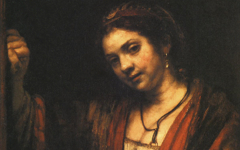Rembrandt’s Self-Portrait with Saskia (c.1635)
This painting of Rembrandt with his wife Saskia was long understood as an image of the two Rembrandts, he then wealthy and successful, "living it up". Then in the 1960's historians introduced the idea that Rembrandt was acting out the story of the Prodigal Son, a belief accepted and expanded on by many scholars since. Even so, they still cannot agree on the portrait's nature: is it historical, moralizing or confessional?1 I do not know what story, if any, the picture depicts on the literal level. Though interesting to know, it is unlikely to change the meaning of the poetic level underneath: Rembrandt is painting Saskia, his feminine self, in a quest for self-knowledge and Wisdom. Here's how.
Both figures are dressed in old-fashioned costumes, Rembrandt a swashbuckler with sword and plumed hat, Saskia resembling a lady of loose morals. One expert has described Saskia as sitting on the artist's knee though how that happens is bewildering. Her head is far too high for that, even if she were a tall woman. Besides, some tassles hanging from red velvet below suggest she is sitting on a stool far too close to the table for comfort.
Worth noting, perhaps even for the first time, are their similar faces, two identical pairs of eyebrows and eyes over a short, rounded nose on a plump face. Saskia, whatever she looked like in life, here shares those features with her husband. Nevertheless, a difference of upbringing and temperament between the two has been noted.2 Another, with some justification, has wondered if this image is not a celebration, a reflection of the painter's self-satisfaction at having passed from promising young artist to accomplished and acclaimed master." It might be.
Click next thumbnail to continue
It might be because Rembrandt's figure is brightly lit with deep shadows and rounded forms while Saskia in her green dress looks flat and unfinished like a painting. Note how the artist's gold or gilt sword hilt pops out of the frame on the right while its sheath descends down into darkness on the left. It is like so many other swords in art the painter's "brush", passing from the reality of the studio into the "image" Rembrandt is in the process of creating.
Click next thumbnail to continue
His hand on her back is the crux of the painting. Lit head on as though from a studio window, there is little sign that the fabric moves in reaction to the touch or that its shadow wavers over the folds of the dress.3 His hand, lit by its own light, touches the canvas and "paints" his wife. Touching, as explained elsewhere, is an age-old metaphor in art for painting.
Click next thumbnail to continue
Rembrandt, for his part, looks out over his shoulder, as artists do to look in the mirror while painting a self-portrait.The indeterminate space in which Saskia sits, too high for the table and too close, reinforces Rembrandt's underlying idea that she is in a "painting" with its own space; he outside it "in the studio." A curtain which had been popular in the Renaissance to cover paintings hangs from the top edge of our painting as though waiting to cover the portrait of Saskia.
Click next thumbnail to continue
In an engraving of Rembrandt with his wife, created around the same time, the same characteristics appear. Rembrandt is gaudily dressed in the foreground with highlights and deep shade while his wife in indeterminate space behind him appears loosely drawn with soft shadows and light from a different direction. Rembrandt's hand, meanwhile, too small for his own figure though in scale with hers, crosses out of the studio space into the etching's. Saskia is Rembrandt's "engraving."
See conclusion below
More Works by Rembrandt
Notes:
3. This is similar to how the foot of Titian's reclining Venus makes no impact on the jacket of the musician to her left.
Original Publication Date on EPPH: 18 May 2011. | Updated: 0. © Simon Abrahams. Articles on this site are the copyright of Simon Abrahams. To use copyrighted material in print or other media for purposes beyond 'fair use', you must obtain permission from the copyright owner. Websites may link to this page without permission (please do) but may not reproduce the material on their own site without crediting Simon Abrahams and EPPH.








